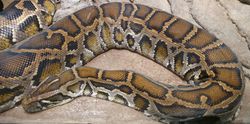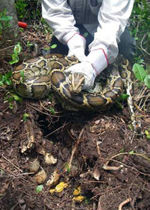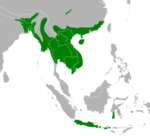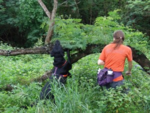Burmese python
| Burmese python |
|---|
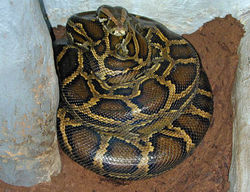
|
| Scientific Classification |
|
| Binomial Name |
|
Python bivittatus |
The Burmese python is a species of python known by the scientific name Python bivittatus. They are the fifth largest snake in the world, averaging twelve to sixteen feet and two hundred pounds. The Burmese python is carnivorous and feeds on a variety of birds and mammals as well as some reptiles, amphibians and fish. Being one of the largest snakes they have also been known to feed on larger animals such as deer and pigs. The Burmese python can live in a wide range of habitats such as tropical forests, savannahs, and tropical islands. They were originally brought to Florida as part of the pet trade, and have adapted to living in the suburbs making them an especially dangerous invasive species.
Body Design
The Python bivittatus is one of the largest snakes in the world, the largest Burmese python was 23 feet (701.04 centimeters) and weighed more than 200 pounds. [2] Males average 12 feet (365 centimeters) in length and females average 16.6 feet (506 centimeters). [3] Males and females weigh on average of 200 pounds. Burmese python hatchlings can reach up to 19-31 inches (50-80 centimeters) and can weigh on average and can double in size within a year.[4]
Burmese pythons are covered in smooth scales all over their body. They have a stout-body and have dark dorsal blotches and lateral markings outlined in dark brown or black. The dorsal blotches vary in size and shape that extend laterally to the belly. The belly is dark spotted and light-colored in the center. On the top of the head there is a light stripe on the head from the temporal region, through the eye, and through the nose. The juvenile's pattern is very similar to one of an adult, except their coloration is a more vibrant color.[5]
Life Cycle
The Burmese python is ready to lay its eggs in 2-4 months after mating. It can lay huge amounts of eggs. A Burmese python can live 20 years or more, the longest recorded life span of a Burmese python is 28 years and 3 months. [6]. The Burmese python is oviparous. The Burmese python is a carnivore, they eat birds, mammals and reptiles. Some snakes in the wild do not eat everyday, sometimes every other day. [7]. A Burmese python on average lays twenty-four to thirty-six eggs, but it can lay up to one hundred eggs at a time. The Burmese python over its life time can grow up to an average of fifteen feet, the largest ever recorded is forty-nine feet Cite error: Invalid <ref> tag; invalid names, e.g. too many.
A Burmese python will grow about 4 feet in 3 years. The Burmese python reproduces sexually. Incubation last for 2-6 weeks. When the female is ready to reproduce, she releases pheromones. A Burmese python on average stays with the babies for a month to six weeks after they have hatched. once the mother goes away, the baby snakes eat mice until they can hunt for themselves, the still eat mice but once they mature they can care for themselves.
Ecology
The Burmese python feeds on a variety of birds and mammals as well as reptiles, amphibians, and fish. Being one of the largest species of snakes the Burmese python may also feed on large animals such as pigs and deer.[6] Burmese python's spend their mornings soaking up the sun’s warmth, enabling them to move around to look for food. [8] There are no known predators that specialize on the Burmese python. The only documented predators of the Burmese python are alligators, monitor lizards, jackals, and humans. Adult pythons are relatively invulnerable to predators, except when they are digesting a large meal. In its native range the Burmese python may control rodent pests in agricultural settings and around some human habitations. [9]
The Burmese python can live in a variety of habitats such as tropical forest, savannahs, riparian areas, marshes and swamps, and continental tropical islands, from sea level to moderate elevations. The presence of humans have forced them to adapt to living in cultivated sites and even in the suburbs. When needed they can also stay underwater for as long as thirty minutes. They are native to Southern China, Eastern India, Myanmar, Thailand, Laos, Cambodia, Vietnam, Nepal, Bangladesh, Northern continental Malaysia, and Western Indonesia. [10]
Invasive Species
Location and Method of Introduction The Burmese python is native to India an Southeast Asia, but they are now also found in Southern Florida. They were originally brought to America to be exotic pets. However when they got to big or the owner did not want to keep them anymore they would let the Burmese python out into the wild. They unlike other species were able to survive in the wild. Which led to the introduction of the Burmese python to the Everglades in Florida. [11]
Environmental Impact The Burmese python is known to prey on many animals such as raccoons, rabbits, bobcats, House Wrens, and even White-tailed deer. All of these species have shown a rapid decline in their population since the Burmese python was introduced into Florida. Many critically endangered animals, such as the Wood Rat, have been found in the digestive systems of Pythons. The Burmese pythons are disrupting the natural food chain in Florida. This can cause many serious impacts to the ecosystem. Burmese pythons also present a threat to native snakes, such as the Eastern Diamondback and the Eastern Indigo snake. The Burmese pythons do not leave enough food for these native snakes causing them to starve. [12] In areas where the Burmese pythons have established themselves, marsh rabbits and foxes can no longer be found. They also happily eat pets, including cats, dogs and some farm animals. sightings of raccoons, opossums and white-tailed deer have all decreased more than ninety percent in areas were the Burmese python is well established. [13]
Control Methods
Although the Burmese pythons are an invasive specie scientists have not yet found out a specific method to control the large population of the Burmese python. While there if no specific method there are other ways to keep the population to a controllable number. Some ways to keep to control them are road cruising, bio-controls, dogs, bounty hunters/hunting season, and trapping.[14] Another efficient method that scientists use are radiotelemetry and other technology to where they like to live, how far they move, and locate their breeding groups.Cite error: Invalid <ref> tag; invalid names, e.g. too many But there is no official way to get the population of the Burmese python to a minimum or to completely keep them out of the picture. So people, scientist, and hunters are just using methods to keep the Burmese python controllable.
References
- ↑ Python bivittatus Wikispecies. Web. last modified on 22 November 2015. Author unknown.
- ↑ Harvey, Rebecca G. Brien, Matthew L. Cherkiss, Michael S. Dorcas, Michael Rochford, Mike Snow, Ray W. and Frank J. Mazzotti, Frank J. Burmese Pythons in South Florida: Scientific Support for Invasive Species Management University of Florida (EDIS). Web. Date of last access November 12, 2015.
- ↑ Python bivittatus Florida Museum of Natural History. Web. Date of last access November 16, 2015. Author unknown.
- ↑ Harvey, Rebecca G. Brien, Matthew L. Cherkiss, Michael S. Dorcas, Michael Rochford, Mike Snow, Ray W. and Frank J. Mazzotti, Frank J. Python bivittatus Florida Museum of Natural History. Web. Date of last access November 20, 2015.
- ↑ Python bivittatus Florida Museum of Natural History. Web. Date of last access November 20, 2015. Author unknown.
- ↑ 6.0 6.1 Burmese Python SeaWorld Parks & Entertainment. Web. Accessed November 13, 2015. Unknown Author
- ↑ Burmese Python ISSG. Web. Last modified January 10, 2010. Unknown Author
- ↑ Burmese Python Smithsonian National Zoological Park. Accessed November 17, 2015. Unknown Author
- ↑ Python molurus bivittatus Invasive Species Compendium. Accessed November 16, 2015. Unknown Author
- ↑ Python molurus bivittatus Global invasive species database. Last modified January 21, 2010. Unknown Author
- ↑ Invasive Pythons in the Everglades Davidson Biology. Web. Date of last access December 2, 2015.Author unknown.
- ↑ Invasive Species Burmese Python Invasive Species Burmese Python. Web. Date of last access December 3,2015. Unknown Author
- ↑ Pythons have stranglehold on Florida Everglades ecosystem USA today. December 4, 2015. Unknown Author
- ↑ Invasive Pythons in the Everglades Davidson Biology. Web. Date of last access December 2, 2015.Author unknown.
